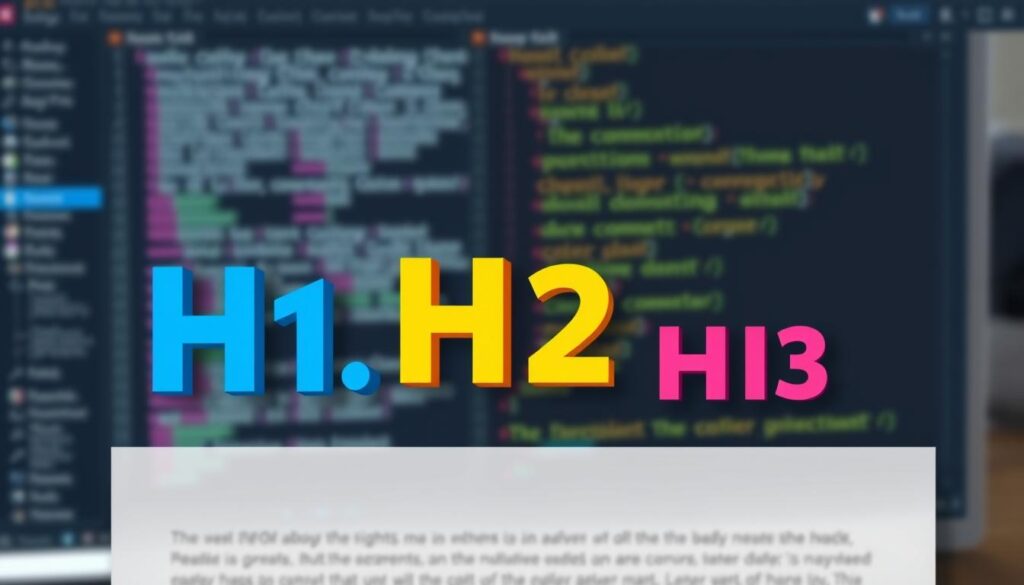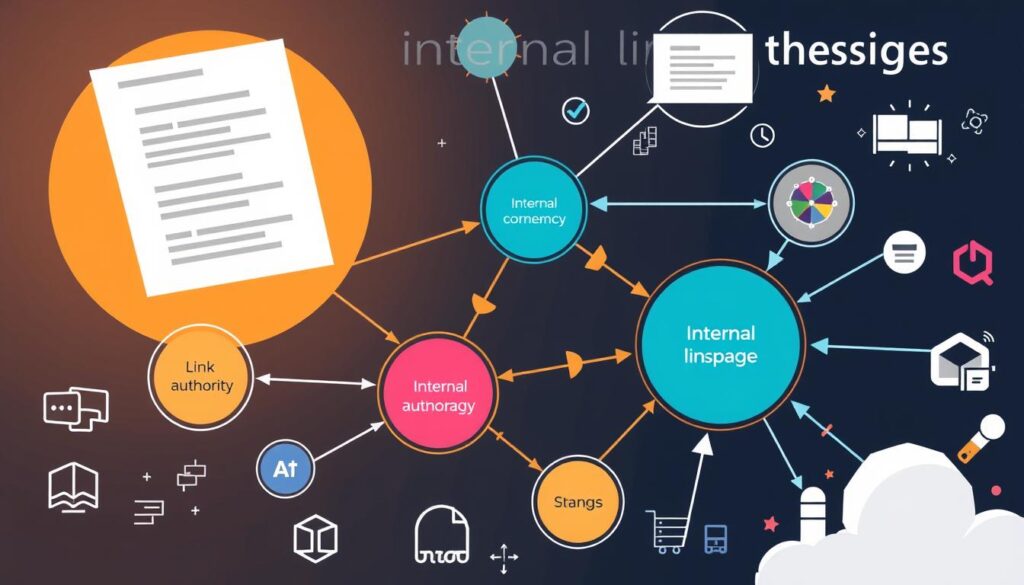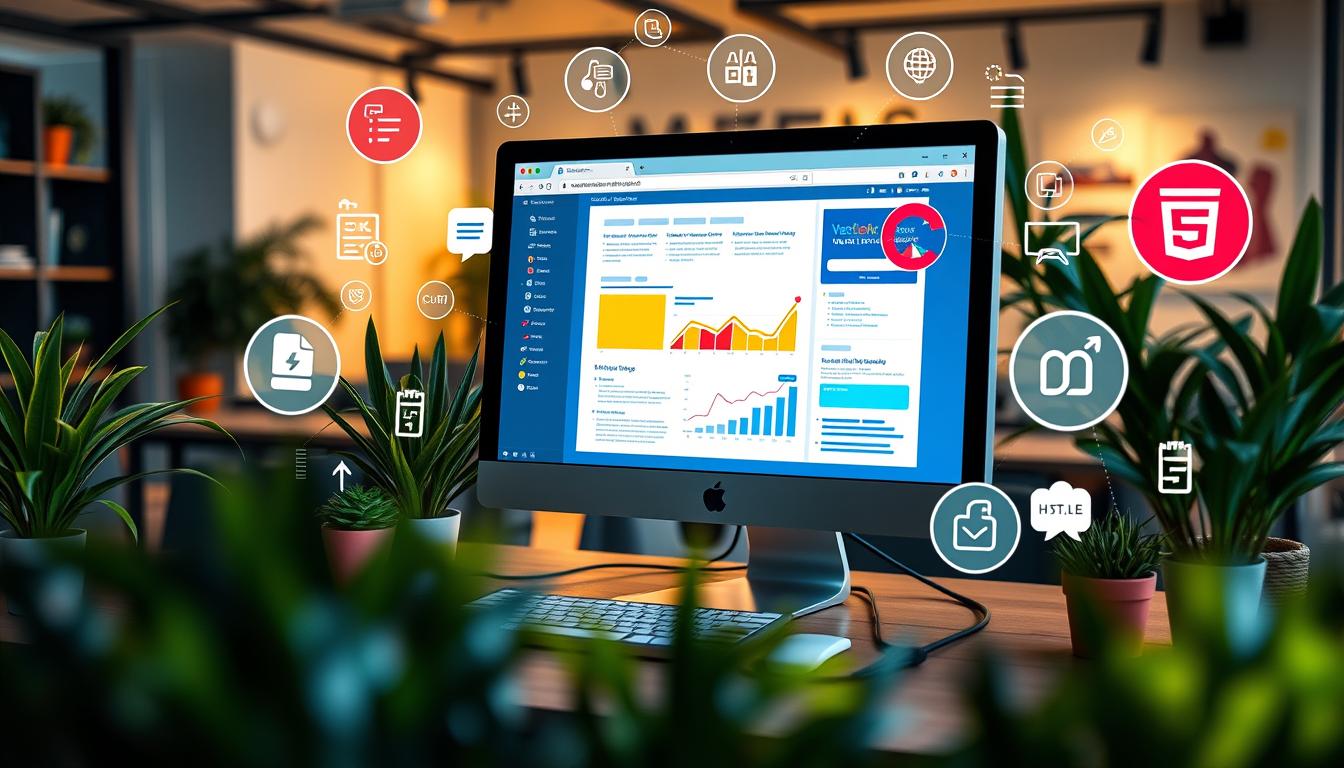Did you know that over 90% of websites never achieve a first-page ranking on search engines? The secret to avoiding this fate lies in the art of on-page optimization. In a world where visibility and discoverability are paramount, mastering this strategy can be the difference between a thriving website and one that remains in obscurity.
In this comprehensive guide, we delve into the essential elements of on-page optimization. We will uncover the strategies that can propel your website to the top of search engine rankings. From keyword research to content creation, title tags to internal linking, you will learn the techniques that industry experts employ. These techniques drive traffic, engage audiences, and outshine competitors.
Key Takeaways
- On-page optimization is crucial for improving search engine rankings and website visibility.
- Keyword research and strategic placement are essential for effective on-page SEO.
- Creating high-quality, user-centric content can significantly boost your website’s performance.
- Optimizing elements like title tags, meta descriptions, and header tags can enhance your online presence.
- Leveraging internal linking and image optimization techniques can further improve the user experience and search engine crawlability.
What is On-page Optimization?
In the digital marketing realm, on-page SEO stands as a pivotal element of website optimization. It involves optimizing individual web pages to enhance their visibility and ranking on search engine algorithms. This, in turn, drives more organic traffic to your site.
Definition and Importance
On-page optimization encompasses various techniques and strategies aimed at improving a web page’s content, structure, and user experience. By optimizing these elements, you signal to search engines that your page is relevant, authoritative, and worthy of higher rankings.
Key Elements of On-page Optimization
The core elements of on-page optimization include:
- Keyword research and integration
- Crafting quality, engaging content
- Optimizing title tags, meta descriptions, and header tags
- Improving image optimization and alt text
- Enhancing internal linking structure
- Ensuring mobile-friendly website design
By addressing these on-page factors, you can create a well-structured, user-friendly website. Such a website is easily crawlable, indexable, and rankable by search engines. This boosts your visibility and drives more qualified leads to your business.
The Role of Keywords in On-page SEO
Developing an effective on-page SEO strategy relies heavily on the strategic deployment of keyword research and long-tail keywords. These instruments are pivotal in uncovering the precise terms and phrases that your target audience employs in their searches. This knowledge empowers you to refine your content, thereby enhancing its visibility within search engine results.
Keyword Research Strategies
The cornerstone of on-page optimization is keyword research. Initiate by compiling a list of pertinent keywords and phrases. Subsequently, leverage online tools such as [https://moz.com/keyword-research-guide/on-page-keyword-optimization] to unearth related long-tail keywords. Analyze their search volume and competition levels. This information will serve as a compass, guiding your selection of the most efficacious keywords to integrate into your content.
Keyword Placement Best Practices
- Incorporate keywords naturally into your content, avoiding keyword density issues.
- Utilize keywords in your page titles, headings, and meta descriptions to signal relevance to search engines.
- Strategically place keywords throughout your text, ensuring a smooth and engaging reading experience.
- Leverage long-tail keywords to target more specific user queries and reduce competition.
By excelling in keyword research and adhering to best practices for keyword placement, you can optimize your on-page content. This optimization will enable your content to achieve higher rankings in search engine results. Consequently, it will attract the appropriate audience to your website.
Crafting Quality Content
In the realm of online content optimization, the creation of high-quality, engaging content stands as a paramount necessity. The essence of effective content marketing resides in the comprehension of the user’s intent, thereby aligning your content strategy accordingly. By immersing yourself in the needs and preferences of your target audience, you can forge content that resonates deeply, thereby driving significant user engagement.
Understanding User Intent
Before embarking on the content optimization journey, it is crucial to grasp the underlying intent behind your audience’s search queries. Are they in pursuit of informative content, aiming to make a purchase, or merely exploring a topic? By discerning the user’s intent, you can craft content that offers the most valuable and pertinent information, thereby enriching their overall experience.
Content Length and Structure
The optimal length and structure of your content significantly influence its efficacy. Though there is no universal formula, studies indicate that content spanning between 1,000 to 2,500 words often excels in terms of content strategy and search engine visibility. Furthermore, organizing your content into clear, well-structured sections with informative headings can enhance readability and user engagement.
The Importance of Originality
- Providing unique and valuable content is essential for standing out in the crowded online landscape.
- Avoid simply regurgitating information that is already available elsewhere on the web.
- Strive to offer fresh perspectives, in-depth analysis, or practical solutions that address your audience’s specific needs.
By concentrating on content optimization, understanding user intent, and delivering original, well-structured content, you can establish a robust user engagement strategy. This strategy will drive meaningful results for your business or website.
Title Tags: Your First Impression
In the realm of search engine optimization (SEO), title tags are pivotal in capturing the attention of potential readers. As the initial element users encounter in search engine results, your title tag is crucial for enhancing click-through rate and website visibility. The art of crafting effective title tags is fundamental to on-page optimization, significantly influencing rankings and online presence.
Best Practices for Title Tags
To forge compelling and SEO-optimized title tags, adhere to these best practices:
- Adhere to a 50-60 character limit for optimal readability and visibility in search engine results.
- Integrate your target keywords proximally to the title tag’s commencement for maximum efficacy.
- Ensure your title tags accurately depict the page’s content, offering a clear and concise synopsis.
- Avoid keyword stuffing and maintain a natural, human-readable tone in your title tags.
- Diversify your title tags across different pages to circumvent duplicate content issues.
Tools for Crafting Effective Titles
Utilizing the appropriate tools can significantly augment your title optimization endeavors. Some indispensable resources include:
- Keyword research tools like Google Keyword Planner to identify high-performing meta tags.
- Title tag preview tools to visualize how your title will appear in search engine results.
- A/B testing platforms to experiment with diverse title tag variations and gauge their efficacy.
By honing the skill of crafting effective title tags, you can create a lasting first impression on your target audience, thereby enhancing your overall SEO performance. Dedicate time to optimizing your title tags, and observe a marked increase in your website’s visibility and click-through rates.
Using Meta Descriptions Effectively
In the realm of digital marketing, meta descriptions are pivotal in boosting click-through rates (CTR) and enhancing your website’s SERP visibility. These concise text snippets act as the initial communication bridge between your content and potential readers. They provide a preview of what your page offers.
Writing Compelling Meta Descriptions
Creating an engaging meta description necessitates a fine balance between accurately summarizing your page’s content and enticing users to click. The essence lies in crafting a unique, informative, and persuasive description that captivates your target audience. It’s crucial to incorporate relevant keywords that match the user’s search query, while ensuring a natural and captivating tone.
Character Limits and SEO Impact
- Meta descriptions generally have a limit of around 160 characters, including spaces, for optimal display on SERPs.
- Sticking to this character limit is vital, as search engines may cut off longer descriptions, potentially diminishing their effectiveness.
- Optimizing meta descriptions for both meta descriptions and SERP snippets can significantly enhance your website’s CTR optimization, leading to increased traffic and engagement.
By grasping the significance of meta descriptions and honing your skills in crafting them, you can elevate your on-page SEO strategy. This will improve your website’s visibility in the dynamic digital landscape.
Header Tags and Their Significance
In the realm of on-page optimization, the strategic deployment of header tags (H1, H2, H3, and so forth) emerges as a pivotal element in content organization and structure enhancement. These tags facilitate search engines’ comprehension of your webpage’s hierarchy and relevance. Concurrently, they elevate the user experience by offering a clear, intuitive navigation framework for your readers.
Organizing Content with Header Tags
The judicious application of header tags enables the creation of a coherent, logical content flow. The H1 tag is designated for the primary title of your page, with H2 and H3 tags serving to delineate main sections and subsections, respectively. This hierarchical framework simplifies navigation and comprehension for both search engines and your audience.
SEO Benefits of Proper Header Usage
- Improved content structure: The deployment of well-organized header tags enhances search engines’ comprehension of your page’s elements, facilitating more precise indexing and ranking.
- Enhanced semantic HTML: The correct utilization of header tags enriches your webpage’s semantic structure, a trait highly regarded by search engines for its capacity to convey clear, meaningful context.
- Increased accessibility: Header tags augment your content’s accessibility, facilitating easier navigation and comprehension for users with disabilities, such as those employing screen readers.

By honing the skill of header tag optimization, you can effectively convey the hierarchy and importance of your content. This, in turn, enhances search engine visibility and enriches the user experience for your audience.
Image Optimization Techniques
Optimizing images is essential for boosting your website’s on-page SEO. By concentrating on image optimization, alt text, and file name best practices, you can notably enhance your search engine visibility and user experience.
Importance of Alt Text
Alt text, or alternative text, serves as a descriptive caption that offers insights about an image to search engines and users who cannot see the image. Optimizing your alt text effectively improves accessibility and aids search engines in comprehending the content and context of your images. This leads to enhanced indexing and ranking.
File Name Best Practices
The file name of your images is a critical aspect of image optimization. Refrain from using generic or irrelevant file names such as “IMG_1234.jpg”. Instead, opt for descriptive, keyword-rich file names that accurately depict the image’s content. This facilitates search engines in better understanding the image and its relevance to your web page.
Furthermore, compressing your image files is crucial to reduce their size and enhance page load speed. This is vital for both user experience and search engine rankings.
By adopting these image optimization strategies, you can significantly improve the visibility and performance of your web pages. This, in turn, leads to superior search engine rankings and enhanced user engagement.
Internal Linking Strategies
Effective internal linking is a pivotal element of on-page site structure, significantly enhancing your website’s link equity. Strategically placing internal links improves user navigation, distributes authority across your pages, and elevates your search engine rankings.
How Internal Links Improve Navigation
Internal links serve as a digital roadmap, guiding visitors through your website’s content. By linking related pages, you can:
- Reduce bounce rates and increase time spent on your site
- Encourage users to explore more of your content
- Establish a clear hierarchy and logical flow for your website
Best Practices for Internal Linking
To maximize the impact of your internal linking strategy, consider the following best practices:
- Relevant Anchor Text: Utilize descriptive and keyword-rich anchor text to provide context and value for your links.
- Contextual Placement: Strategically place internal links within your content, where they naturally complement the surrounding text.
- Hierarchical Structure: Establish a clear site structure, with top-level pages linking to relevant lower-level pages, to distribute link equity effectively.
- Moderation: Avoid excessive internal linking, as it can negatively impact user experience and search engine crawling.
By implementing these internal linking strategies, you can enhance your website’s navigation, improve its site structure, and leverage the power of link equity to boost your overall on-page optimization efforts.

Mobile Optimization and User Experience
In today’s mobile-first world, optimizing your website for mobile devices is crucial for delivering an exceptional user experience. It also ensures a strong online presence. The significance of mobile responsiveness cannot be overstated, given the increasing trend of accessing websites and content on the go via smartphones and tablets.
Importance of Mobile Responsiveness
A mobile-friendly design ensures your website adapts seamlessly to various screen sizes and devices. This provides users with a comfortable and intuitive browsing experience. Such optimization not only enhances user satisfaction but also positively impacts your search engine rankings. Google prioritizes mobile-friendly websites in their search results.
Tools for Testing Mobile Optimization
To ensure your website is optimized for mobile devices, numerous tools and resources are available. Google’s Mobile-Friendly Test allows for quick assessment of your pages’ mobile-friendliness. It offers valuable insights and recommendations for improvement. Tools like PageSpeed Insights and Lighthouse are also beneficial. They help identify and address issues related to page load speed, a critical factor for mobile user experience.
